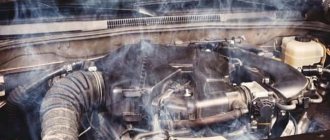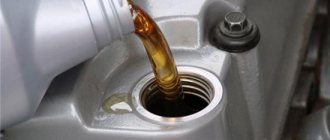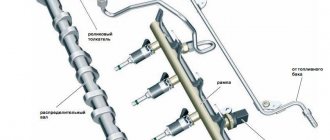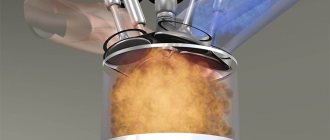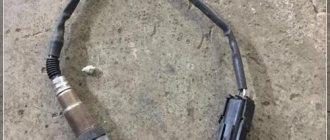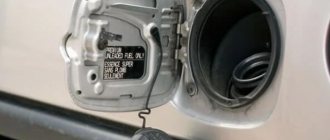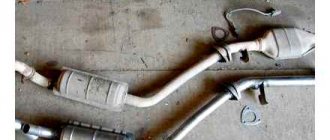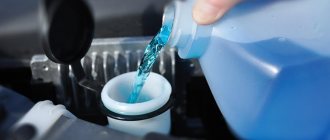Why is oil leaking from under the valve covers? Let’s say right away that if an oil leak is detected at the place where the valve covers are bolted to the cylinder head of a VAZ, or oil flows from the neck, then there is only one reason - increased pressure in the lubrication system. If a leak is found at the junction of the cover with the cylinder head, then this is either high pressure or the gasket between the cover and the cylinder head is worn out.
The VAZ 2114 gasket is constantly exposed to high temperatures, therefore, over time, it naturally wears out: it loses its elasticity, cracks and ceases to fit tightly to the surfaces of the parts. To restore tightness, it is enough to replace the worn gasket with a new one. The second reason for oil leakage in the VAZ 2110 is a more serious case. We need to figure out: why did the pressure rise in the system? But first, the pressure needs to be measured.
Why does oil leak?
Automotive oil is one of the main components of stable and long-term operation of the power unit. The engine system includes a large number of different covers and pans to keep the lubricant inside. One such element that retains oil is the valve cover. It is installed on the cylinder head. This implies its direct purpose - timing belt sealing. It is thanks to the cover that every driver can be sure that no dust or moisture will get inside the engine.
Oil leaks can occur for many reasons. Sometimes lubricant leaks at the junction of the cylinder head and the cover, and there are cases when oil leaks at the place where the bolts are attached. In any case, if you find traces of a substance, then pay attention to the following details and elements, which often become the cause:
- Pad;
- Valve and oil cover;
- Bolts and other fasteners.
Gasket - all the reasons for oil leaks are often associated with this element. The gasket is made of rubber. This seal constantly heats up while the engine is running and cools down when the engine is turned off. It is quite natural that temperature effects on the gasket do not give it strength, but, on the contrary, form cracks in its structure. Over time, the seal loses its elasticity and ceases to fit tightly to the surface of the cover, which causes oil leaks.
But it’s not always just the gasket that fails. Today, under the hood of many modern cars you can find a plastic valve cover. It is quite easy to damage, and it can also burst during winter frosts. Bolts and any other fasteners very often become a problem area. It is enough just not to tighten the bolt - oil will ooze out. It's a good idea to check all studs and bolts as they can break if you over tighten them.
Do I need to lubricate the rubber gasket with sealant?
Auto mechanics have different opinions about the use of sealant. Some consider its use unacceptable, while others, on the contrary, argue that only with it can complete tightness be achieved. Let's just say that if the surfaces of the cover and cylinder block are rough, the use of sealant is desirable, but only if it is applied in a neat, thin layer. If the surfaces are perfectly flat, you can do without it, because a few years ago no one really used such a sealant. Well, for cars where the gasket is not provided for by the design, sealant is indispensable.
High pressure in the lubrication system
If all the above reasons are quite simple and harmless, then high pressure in the engine lubrication system is already evidence of the presence of much more serious malfunctions. In this case, you cannot do without a comprehensive and complete inspection of the car. Most motorists know that an oil pressure light on the instrument panel indicates low pressure in the system. If, on the contrary, this characteristic is too high, the driver will have no way of knowing about it. The only solution is manual measurement.
Use a liquid pressure gauge, but before you move directly to measuring pressure, find out what is considered normal for a particular engine. You can find out the pressure rating in the operating instructions. High blood pressure is a problem that needs to be addressed urgently. But before you correct the situation, you need to know the reasons why this parameter could jump sharply. The reasons may be the following:
- Incorrect operation of crankcase ventilation. In this case, accumulating gases cause an increase in this parameter. The pressure literally forces the oil out from under the valve cover.
- Clogged oil system channels also cause increased pressure.
- Using high viscosity oil and increasing its level can all cause the lubricant to leak out from under the cap.
Once the cause has been discovered, you can move on to the stage of effectively eliminating it.
Useful tips and tricks
- It should be remembered that high-quality elimination of oil leaks from under the valve cover requires the correct choice of gasket under the valve cover. To do this, it is optimal to purchase original products or high-quality recommended analogues from well-known manufacturers.
- Before purchasing, the gasket should be carefully inspected, checked for elasticity, and made sure there are no sagging or other defects. The element should not be hard or overdried; even the smallest cracks are not allowed.
- For vehicles that use sealant on the valve cover, only recommended or proven sealant compounds should be used.
In this case, it is imperative to strictly follow the application technology. It should also be noted that applying an additional layer of sealant to the rubber gasket is a common practice, and there are a large number of both supporters and opponents of this method. - If the mating surfaces of the valve cover and/or cylinder head do not have a smooth surface and are uneven, then many auto mechanics additionally apply a thin layer of sealant while installing a new gasket. In this situation, the sealant allows for a better sealing of the joint, but the overall life of the gasket and the seal is usually short. If there are no defects on the adjacent surfaces, then it is better not to use sealant for preventive purposes.
- When installing and tightening the valve cover bolts, you must follow the vehicle manufacturer's recommendations and tighten the valve cover bolts in the correct sequence and only to the recommended torque.
How to fix a leak from under the valve cover?
If the whole problem is due to the gasket, then it is enough to replace it with a new one. It is best to choose a high-quality original-made seal from time-tested manufacturers. The gasket must be elastic, without various defects and damage. The valve cover and oil cover also need to be replaced. But here car owners often have difficulty making a choice. When replacing the valve cover, pay attention to metal counterparts. They are more expensive than plastic covers, but much more practical and reliable.
In the case of high blood pressure, it will be more difficult to eliminate this problem. Clearing clogged ducts often helps. But there are also more severe cases that require a comprehensive, professional approach. When installing a new valve cover, be sure to follow the manufacturer's recommended sequence and torque. If replacing all the elements did not help, and cleaning the crankcase ventilation also did not help, then pay attention to the pressure reducing valve. This valve most often fails due to excessive contamination. It is enough to clean it or, in extreme cases, replace it.
If oil leaks from the neck or at bolted joints
It happens that oil does not flow from the junction of the mating surfaces of the cylinder head and the valve cover, but, for example, from the oil filler neck or where there is a bolted connection. The cause of such leaks is the same excess pressure. Having eliminated the causes of the increased pressure, it is recommended to replace the rubber seals of the bolts (if they are provided for in the design), and also check the tightness of the oil filler cap.
Why does oil leak?
Automotive oil is one of the main components of stable and long-term operation of the power unit. The engine system includes a large number of different covers and pans to keep the lubricant inside. One such element that retains oil is the valve cover. It is installed on the cylinder head. This implies its direct purpose - timing belt sealing. It is thanks to the cover that every driver can be sure that no dust or moisture will get inside the engine.
Oil leaks can occur for many reasons. Sometimes lubricant leaks at the junction of the cylinder head and the cover, and there are cases when oil leaks at the place where the bolts are attached. In any case, if you find traces of a substance, then pay attention to the following details and elements, which often become the cause:
- Pad;
- Valve and oil cover;
- Bolts and other fasteners.
Gasket - all the reasons for oil leaks are often associated with this element. The gasket is made of rubber. This seal constantly heats up while the engine is running and cools down when the engine is turned off. It is quite natural that temperature effects on the gasket do not give it strength, but, on the contrary, form cracks in its structure. Over time, the seal loses its elasticity and ceases to fit tightly to the surface of the cover, which causes oil leaks.
Main causes of leakage
So we’ve come to the main reasons, guys, I’ll tell you right away there are not many of them! I would even say just three:
- Pad
- The valve cover itself
- Studs, bolts, nuts
- Oil cover
Only for these reasons can a leak occur, it is certainly not intense, but either here or like this you can see smudges from above, which are also covered with dust and dirt! I can tell you from my own experience - it’s terribly annoying. Well, let's take a closer look at each of the problems.
High pressure in the lubrication system
If all the above reasons are quite simple and harmless, then high pressure in the engine lubrication system is already evidence of the presence of much more serious malfunctions. In this case, you cannot do without a comprehensive and complete inspection of the car. Most motorists know that an oil pressure light on the instrument panel indicates low pressure in the system. If, on the contrary, this characteristic is too high, the driver will have no way of knowing about it. The only solution is manual measurement.
Use a liquid pressure gauge, but before you move directly to measuring pressure, find out what is considered normal for a particular engine. You can find out the pressure rating in the operating instructions. High blood pressure is a problem that needs to be addressed urgently. But before you correct the situation, you need to know the reasons why this parameter could jump sharply. The reasons may be the following:
- Incorrect operation of crankcase ventilation. In this case, accumulating gases cause an increase in this parameter. The pressure literally forces the oil out from under the valve cover.
- Clogged oil system channels also cause increased pressure.
- Using high viscosity oil and increasing its level can all cause the lubricant to leak out from under the cap.
Once the cause has been discovered, you can move on to the stage of effectively eliminating it.
What is important to know about crankcase gas pressure?
By changing the valve cover gasket, you often only eliminate the consequences of the malfunction for a short time. It is much more important to determine the causes of lubricant leakage, since neither the exemplary geometry of the mating planes, nor a high-quality gasket and following the instructions will protect against oil leakage if there is an increased pressure of crankcase gases inside the engine. The crankcase mixture consists of an unburned air-fuel mixture that penetrates the crankcase through the piston rings and an oil suspension. The operation of the exhaust gas ventilation system is aimed at supplying the explosive mixture back into the intake tract.
How to fix a leak from under the valve cover?
If the whole problem is due to the gasket, then it is enough to replace it with a new one. It is best to choose a high-quality original-made seal from time-tested manufacturers. The gasket must be elastic, without various defects and damage. The valve cover and oil cover also need to be replaced. But here car owners often have difficulty making a choice. When replacing the valve cover, pay attention to metal counterparts. They are more expensive than plastic covers, but much more practical and reliable.
In the case of high blood pressure, it will be more difficult to eliminate this problem. Clearing clogged ducts often helps. But there are also more severe cases that require a comprehensive, professional approach. When installing a new valve cover, be sure to follow the manufacturer's recommended sequence and torque. If replacing all the elements did not help, and cleaning the crankcase ventilation also did not help, then pay attention to the pressure reducing valve. This valve most often fails due to excessive contamination. It is enough to clean it or, in extreme cases, replace it.
The most severe case is a problem with the piston group. If all the above measures did not help and the oil continues to leak, then there is nothing left but to repair the engine. The fact that there is a malfunction of the piston group is usually indicated not only by an oil leak, but also by a number of other symptoms: multiple oil flows at the junction points of the engine components, a sharp decrease in vehicle power, and unstable operation of the power unit at idle. With all these ailments, it may well be that the piston rings require replacement.
Oil cap
The reason is banal, but it exists! The thing is that the lid also has a gasket on top; of course, not all machines have it; on some it is thin. But those that have one sometimes get destroyed and oil can leak from under it. Although this problem is very quickly identified and eliminated. He simply buys and that’s it.
These are all reasons, often they are banal. BUT it is worth eliminating them; it is not permissible for oil to flow through the engine and get on various external parts, this could be the muffler, timing belt , etc. If oil gets on the belt, it can simply fly off, so we fix it as we see, this is important.
A small useful video.
I’ll end here, I think my article was useful to you, read our AUTOBLOG.
Similar news
- How many valves are there in the engine? Let's look at rare cases
- Distributed or direct injection (MPI or GDI). Which …
- Engine torque and power. What's more important? A few words about...
Add a comment Cancel reply
What does the cap do and why does it leak?
By and large, the valve cover in any engine simply should not allow oil to splash while the engine is running, since in most cases it does not receive load from internal pressure. More precisely, it should not receive it.
Crankcase gases
In fact, the cause of an oil leak may be crankcase gases that create excess pressure above the gas distribution mechanism.
A leak from under the valve cover gasket is a problem for the Chevrolet Lacetti.
In the Chevrolet Lacetti, the crankcase ventilation valve is also responsible for the circulation of crankcase gases. If it is clogged, the pressure under the cap will increase, gases will begin to squeeze out the oil, and the first weak link in their path will be the gasket. In this case, the gasket, no matter how high-quality it is, will not last even five thousand miles. Therefore, if we notice oil leaking from under the Lacetti valve cover, it is worth unscrewing and checking the condition of the crankcase ventilation valve . This can be done in a few minutes with any aerosol carburetor cleaner.
Good and bad lids. Version two
As you know, the Chevy Lacetti has a plastic valve cover . Naturally, the engineers took this step in order to reduce the cost and lighten the engine. This affected the rigidity of the lid. In addition, plastic, even the best one, does not resist thermal deformation as actively as aluminum alloy. Once the engine is thoroughly overheated, the valve covers will begin to move, then there is no need to talk about tightness, the oil will penetrate under the gasket.
To check this version, remove the cover and install it on a flat steel plate (or on glass in extreme cases). If there is a gap of at least a millimeter between the stove and the lid, there is a chance that the gasket will leak . Planning the lid (drawing out the mating plane) is a waste of time, because the plastic is thin and by removing some of the material we will only make it worse, the lid will become even less rigid. The best solution in this situation is to replace the cover.
Version three: gaskets and rings
If we know for sure that the surface of the lid is perfectly flat, the vent valve is clean, but the gaskets are still leaking, the problem is most likely in the gaskets themselves. In addition, some people underestimate the role of the O-rings that are installed under the bolt heads. When replacing the gasket, it is imperative to change these rings. Branded GM seals harden very quickly and begin to leak oil, while rings from Kamaz that are almost the same size (they are white and cost an order of magnitude cheaper) can withstand high temperatures and completely retain elasticity for the entire service life of the gasket.
O-rings for bolts from Kamaz fit perfectly on the Lacetti
But gaskets also come in different quality. The frequency of replacement mainly depends on their quality. Some people prefer to use expensive German ones, while others prefer cheaper domestic ones, but having saved on gaskets, we often replace them. For example, a branded gasket GM96 353 002 costs about 450 rubles, but its service life does not please many . In addition, the material profile is simple square. The Parts Mall96 353 002 gasket performs a little better , but the Victor Reinz gasket with catalog number 155345601 . It has a T-shaped profile, and due to this there is a large area of overlap of the plane of the block head.
Fourth version: bolts, sealants and hands
The gasket, even the highest quality one, must be installed with sealant. It must withstand high temperatures and not harm the catalyst. Many companies produce similar products in huge quantities, but sealant is different from sealant - only one that says “sensor-save” and “High-Temp” on the packaging is suitable for the valve cover . If the manufacturer has indicated these two important properties, then the composition of the sealant should already interest us. If applied correctly it will work great.
The 15 bolts that hold the valve cover to the head plane can stretch over time, causing the metal to fatigue and the threads to become loose. Therefore, many advise changing the bolts with each replacement . Moreover, when tightening, old bolts have a habit of breaking. One bolt costs about 20 rubles (cat. No. 94 500 909 ), which won’t hurt your pocket too much.
Cover mounting bolts.
Another important, if not the main point is gasket replacement technology . It is imperative that you thoroughly wash and clean the surfaces of the head and the lid from any remnants of old sealant, then degrease them, apply the sealant in a thin layer and be sure to let it harden exactly as long as indicated in the instructions.
When tightening bolts, it is highly recommended to use a torque wrench and follow the correct bolt tightening order.
Therefore, we draw conclusions. To prevent the valve cover gasket on the Lacetti from leaking for as long as possible, we control and pay attention to :
- Crankcase ventilation valve.
The original gasket looks ridiculous compared to the Reinz.
ABRO Black sealant.
Of course, this is not a panacea, but if you follow these tips, your valve cover gasket will last much longer. Keep the under hood clean and smooth roads for everyone!
Types of Gasket Defects
Oil leakage from under the cylinder head is most often caused by damage to the gasket. The main reasons for its destruction can be: rupture by gases; overheat; coolant leak; mechanical influences.
Violation of integrity by gases. One of the common causes of damage is associated with strong penetration of the exhaust gas composition between the second and third cylinders (during the exhaust cycle). The elastomer of the gasket is destroyed in the area of the hole for the passage of the coolant. This phenomenon is caused by the following reasons: the penetration of gases into the cooling liquid due to poor tightening of the bolts; lowering the cylinder liner; deformation of elements; surface roughness of parts; Incorrect adjustment of the start of fuel supply.
Engine lubrication system.
Another manifestation is damage in the form of delamination in the area of the pusher hole. The most common reasons: frequent engine overloads; incorrect installation of the sleeve protrusion; non-flat surface of the cylinder head. Breakthrough of a two-layer metal shell by gases occurs as a result of weak tightening of bolts or deformation of elements during thermal overload. Increased pressure in the cooling system due to the penetration of exhaust gases leads to damage to the gasket near the water channels in the form of linear imprints. Such defects are caused by poor-quality processing of the head surface, air remaining in the cooling system, blocking the supply of coolant, and high exhaust gas pressure.
Damage due to overheating. Thermal overheating of a two-layer gasket leads to rupture of the seals. This type of heat load is caused by too low a fuel octane number, too high a compression ratio, incorrect spark plug adjustment, or poor-quality bolt sealing. Quite often, overheating causes swelling of the gasket material near the holes for the coolant to pass through. Main reasons: engine overheating as a result of excessively high coolant temperature; malfunction of the pump or thermostat; interference with the movement of fluid through the cooling system.
Liquid leaks on the surface. Typically, gaskets that combine metal and elastomer are used. Grooves are formed in the cylinder head with dimensions designed to be sealed by the sealing elements of the gasket. If such grooves are poorly cleaned of dirt or carbon deposits, then oil leaks through them. In addition, careless installation can sometimes cause the elastomer layer to collapse, which increases the likelihood of depressurization.
In some cases, oil leakage is caused by the quality of the surface grinding of the mating units. The surfaces of the cylinder block and cylinder head must be very carefully processed; no waviness is allowed on them. Different types of gaskets - a combination of metal - soft material, metal interlayers and metal - elastomer, have specific requirements for the quality of the surface of the parts, and they must be strictly met.
Installation errors. The most common cause of oil leakage is poor tightening of bolts. In this case, there may be a general loosening of the tightening due to fear of pinching the material, as well as uneven tightening of the bolts when a local channel occurs. It is precisely because of the high probability of such defects that it is recommended that repairs or replacement of the gasket be carried out at a service station.
Another common cause is improper gasket selection. It was selected based on thickness and strictly according to the dimensions of the old part. However, there is often a discrepancy between the dimensions of the combustion chamber and the corresponding sample on the gasket. When installing such an element, it is damaged during vehicle operation. Even more common are completely prosaic reasons: the installation of non-branded gaskets purchased from someone unknown. As a result of poor installation, a significant oil leak occurs from under the head, which leads to unplanned fluid losses. If the level drop reaches critical values, the entire engine may be damaged, which will lead to the need for major repairs.
An oil leak in the cylinder head is a rather dangerous defect for a car. If such a malfunction is detected, it is necessary to urgently take measures to eliminate the causes. It is recommended to carry out such work at service centers.
Signs and consequences
You can tell that lubricant is leaking from the crankshaft by the traces of oil under the car and severe contamination of the lower part of the engine. In this case, lubricant can flow not only through the oil seal: the cause is often a failure of the oil filter or pan gasket.
Oil leakage is not a harmless phenomenon: it can provoke the development of serious malfunctions during vehicle operation. Therefore, if signs of a leak appear, it is necessary to conduct a diagnostic inspection on an overpass or pit, having first removed the crankcase protection (if equipped).
The front oil seal is leaking
Experts advise starting the inspection with the front oil seal, since this part is not durable and fails first. The main symptom of a malfunction is contamination of the crankcase, since the lubricant attracts dust and dirt.
The most dangerous consequence of a front oil seal leak is the negative impact on the timing belt. If oil gets on it, it causes slippage during operation, and then a violation of integrity and breakage.
On many engines, a broken belt leads to bending of the valves, which will require expensive repairs: replacing the timing belt, cylinder head gasket, valves with their subsequent grinding, and grinding the cylinder head plane. Additionally, the pistons can be damaged as they come into contact with the valves. Cases have been recorded when the piston was penetrated through a bent valve, and this already requires almost a major overhaul of the engine.
Leak in rear seal
This unit has a longer service life than the front oil seal: most often it is equal to the period of operation of the vehicle before major repairs. A leaking rear oil seal negatively affects the transmission, which becomes dirty due to oil ingress. The result of such pollution is a violation of engine characteristics: a decrease in power, increased gasoline consumption.
Malfunctions of electrical equipment and ECM sensors are less common. Leakage of lubricant from the engine requires constant topping up and systematic checking of the level.
Advantages and disadvantages
Vinyl films have many advantages, but one of the main ones is that the cost of vinyl stickers is relatively low. Pasting the entire body will cost about 30 thousand rubles, and the cost of applying vinyl to individual body elements will be 5-6 thousand rubles, which is quite affordable for most car enthusiasts. The same airbrush will cost 3-4 times more. If we compare it with the Oracal adhesive film, which belongs to the category of inexpensive films, then this difference will be even greater.
Noticeable cost savings when using vinyl films also occur due to the fact that the idea for a future image can be gleaned from the Internet. In this case, you won’t have to resort to the expensive services of a professional artist. And if you have skills in working in the Corel Draw program, then you can even draw a sketch of the future image yourself. And in this case, the DIY car sticker will be one hundred percent original. With the same ease, you can place advertising on your car.
It is also important that the vinyl coating performs a protective function, protecting the body from chips and scratches. And thanks to the relatively large thickness of some films, they can even protect the side of the car, which suffers the most in urban conditions. In addition, vinyl stickers can hide almost any flaws on the car body, which will allow you to avoid having to repaint it and, in the end, again allow you to save a lot of money.
If circumstances change, then the vinyl film can be removed from the car body as soon as possible. But in this case, you must be prepared for the fact that the part of the body on which the film was not applied will be slightly different in color from the places where the vinyl sticker was located. This is due to the fact that the pigmentation of the base paint on the body changes slightly under the influence of sunlight. After some time, everything will return to normal, but at first the differences may be noticeable. This is the main disadvantage of vinyl stickers.

